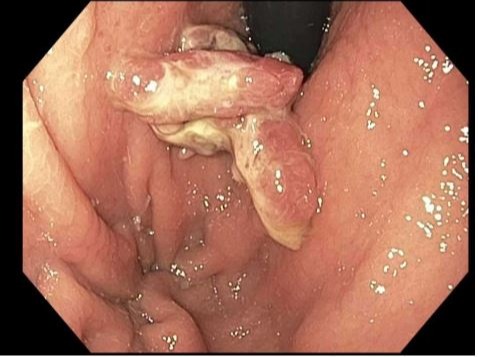Monday Poster Session
Category: GI Bleeding
P2063 - When Uncommon Turns Severe: Massive Gastrointestinal Bleeding Due to Gastric Hyperplastic Polyps
Monday, October 23, 2023
10:30 AM - 4:15 PM PT
Location: Exhibit Hall

Has Audio

Abdellatif Ismail, MBBS, MD
University of Maryland Medical Center Midtown Campus
Baltimore, MD
Presenting Author(s)
Abdellatif Ismail, MBBS, MD1, Andrew Canakis, DO2, Raymond Kim, MD, DM3
1University of Maryland Medical Center Midtown Campus, Baltimore, MD; 2University of Maryland School of Medicine, Baltimore, MD; 3University of Maryland Medical Center, Baltimore, MD
Introduction: Significant gastrointestinal bleeding from gastric polyps is uncommon. Here we present a challenging case of hyperplasitc gastric polyps presenting with massive GI bleeding.
Case Description/Methods: A 58-year-old female presented with hematemesis for three weeks. She admitted to heavy alcohol drinking daily for years. She was found to be ill-looking, pale, with tachycardia, a hemoglobin level of 3 gm/dl, an INR of 1.7 and mildly elevated ALT and AST.
She was managed with intravenous fluids and a transfusion of 5 units of PRBCs and 1 unit of fresh frozen plasma and was admitted to the intensive care unit. Esophagogastroduodenoscopy (EGD) showed a multi-lobulated 20 mm polyp with stigmata of recent bleeding at the gastroesophageal junction. The rest of the EGD was unremarkable. Histopathology was consistent with hyperplastic polyps.
Polyp resection was deferred to be performed by an advanced endoscopist on a later occasion.
She was treated for a few days on the medical floor for alcoholic hepatitis, encephalopathy, and acute kidney injury.
Twelve days later, she had sudden-onset bouts of hematemesis resulting in hemorrhagic shock and transfer to the ICU. EGD showed two 25-35 mm pedunculated bleeding polyps at the gastroesophageal junction and gastric fundus. Bleeding was controlled by epinephrine and hemostatic clips placed along each polyp's stalk.
Ongoing bleeding was suggested by persistently dropping Hb levels; thus, left gastric artery embolization was performed by interventional radiology. After the procedure, she remained hypotensive, requiring vasopressors, with worsening acute kidney injury, possibly due to acute tubular necrosis from hemorrhagic shock and hepatorenal syndrome. As a result, she required continuous renal replacement therapy and prolonged ICU stay where she passed away within the next few days.
Discussion: Gastric hyperplastic polyps are the second most common gastric polyps after fundic gland polyps. They are more common in older individuals and are usually asymptomatic. Other times, they present with anemia due to chronic blood loss. This abstract highlights the uncommon occurrence of massive GI bleeding in these polyps. The management of our patient was further complicated by severe alcoholic hepatitis resulting in encephalopathy, coagulopathy, and hepatorenal syndrome. Notably, our patient did not have esophageal varices, the presumed source of massive GI bleeding in similar patients.

Disclosures:
Abdellatif Ismail, MBBS, MD1, Andrew Canakis, DO2, Raymond Kim, MD, DM3. P2063 - When Uncommon Turns Severe: Massive Gastrointestinal Bleeding Due to Gastric Hyperplastic Polyps, ACG 2023 Annual Scientific Meeting Abstracts. Vancouver, BC, Canada: American College of Gastroenterology.
1University of Maryland Medical Center Midtown Campus, Baltimore, MD; 2University of Maryland School of Medicine, Baltimore, MD; 3University of Maryland Medical Center, Baltimore, MD
Introduction: Significant gastrointestinal bleeding from gastric polyps is uncommon. Here we present a challenging case of hyperplasitc gastric polyps presenting with massive GI bleeding.
Case Description/Methods: A 58-year-old female presented with hematemesis for three weeks. She admitted to heavy alcohol drinking daily for years. She was found to be ill-looking, pale, with tachycardia, a hemoglobin level of 3 gm/dl, an INR of 1.7 and mildly elevated ALT and AST.
She was managed with intravenous fluids and a transfusion of 5 units of PRBCs and 1 unit of fresh frozen plasma and was admitted to the intensive care unit. Esophagogastroduodenoscopy (EGD) showed a multi-lobulated 20 mm polyp with stigmata of recent bleeding at the gastroesophageal junction. The rest of the EGD was unremarkable. Histopathology was consistent with hyperplastic polyps.
Polyp resection was deferred to be performed by an advanced endoscopist on a later occasion.
She was treated for a few days on the medical floor for alcoholic hepatitis, encephalopathy, and acute kidney injury.
Twelve days later, she had sudden-onset bouts of hematemesis resulting in hemorrhagic shock and transfer to the ICU. EGD showed two 25-35 mm pedunculated bleeding polyps at the gastroesophageal junction and gastric fundus. Bleeding was controlled by epinephrine and hemostatic clips placed along each polyp's stalk.
Ongoing bleeding was suggested by persistently dropping Hb levels; thus, left gastric artery embolization was performed by interventional radiology. After the procedure, she remained hypotensive, requiring vasopressors, with worsening acute kidney injury, possibly due to acute tubular necrosis from hemorrhagic shock and hepatorenal syndrome. As a result, she required continuous renal replacement therapy and prolonged ICU stay where she passed away within the next few days.
Discussion: Gastric hyperplastic polyps are the second most common gastric polyps after fundic gland polyps. They are more common in older individuals and are usually asymptomatic. Other times, they present with anemia due to chronic blood loss. This abstract highlights the uncommon occurrence of massive GI bleeding in these polyps. The management of our patient was further complicated by severe alcoholic hepatitis resulting in encephalopathy, coagulopathy, and hepatorenal syndrome. Notably, our patient did not have esophageal varices, the presumed source of massive GI bleeding in similar patients.

Figure: Mulilobulated gastric polyps at the gastric fundus
Disclosures:
Abdellatif Ismail indicated no relevant financial relationships.
Andrew Canakis indicated no relevant financial relationships.
Raymond Kim: Apollo Endosurgery – Consultant. Cook medical – Consultant.
Abdellatif Ismail, MBBS, MD1, Andrew Canakis, DO2, Raymond Kim, MD, DM3. P2063 - When Uncommon Turns Severe: Massive Gastrointestinal Bleeding Due to Gastric Hyperplastic Polyps, ACG 2023 Annual Scientific Meeting Abstracts. Vancouver, BC, Canada: American College of Gastroenterology.
